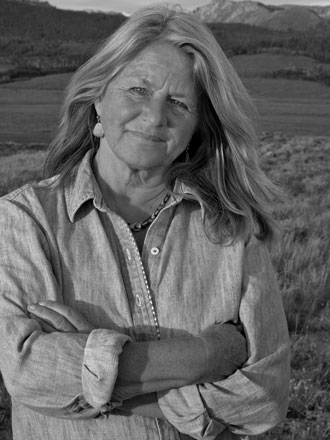by Gretel Ehrlich
All writing is a report from the coiled intestines of consciousness and walks the bridge between natural fact and human meaning always remembering that plants, animals, trees, oceans, mountains and rivers came first, and we arrived later.
And faintly the mountains. Thick snow clouds settle with gestures of affection and are torn away by columns of sunlight, angled rays that stray and collapse. Winds haul massive snow clouds out of the west to cover the peaks. We all have our chores. Mine is to feed and water the horse, haul dirt to the garden. The old cabin I bought is 100 years old, tiny rooms, no closets, but the creek that winds by and spills into a waterfall lured me here and keeps me still.
Up early. Log on fire. The white row of mountain teeth chatters. Between morning and nothing, snow melts. A shelf of wine glasses drops and shatters. Frost-fall dazzles and strikes with glass-like chards. Long-armed stick trees quiver, having forgotten how to bear leaves. Night comes too fast, too early. But it's in the dark hours that I understand fruition. Grasslands smooth out in black carpets. A half-moon stands straight up as if on tiptoe.
My little piece was written in early spring. I try to leave together outside and inside, external and internal views. From the gut to the eyes. I write in all genres and shudder at the idea of boundaries between them. All writing is a report from the coiled intestines of consciousness and walks the bridge between natural fact and human meaning always remembering that plants, animals, trees, oceans, mountains and rivers came first, and we arrived later. We need to be modest in the face of nature's grandeur and complexity of which we are only a tiny part. I write from the wormhole of an abandoned slab of wood.
—
Gretel Ehrlich is the author of 15 books of nonfiction, fiction, and poetry—including The Solace of Open Spaces, Heart Mountain, This Cold Heaven, and Facing the Wave, which was long-listed for the National Book Award. Her work has appeared in Harper's, the Atlantic, Orion, the New York Times Magazine, and Best Essays of the Century, among many other publications. In 2007, the National Geographic Expeditions Council sent her around the top of the world to explore with indigenous Arctic people in Alaska, Nunavut, Greenland and Arctic Russia, how their lives were affected by climate change. She lives with her partner, Neal Conan, on a farm in the highlands of the Big Island of Hawai’i, and a cabin in Montana.

